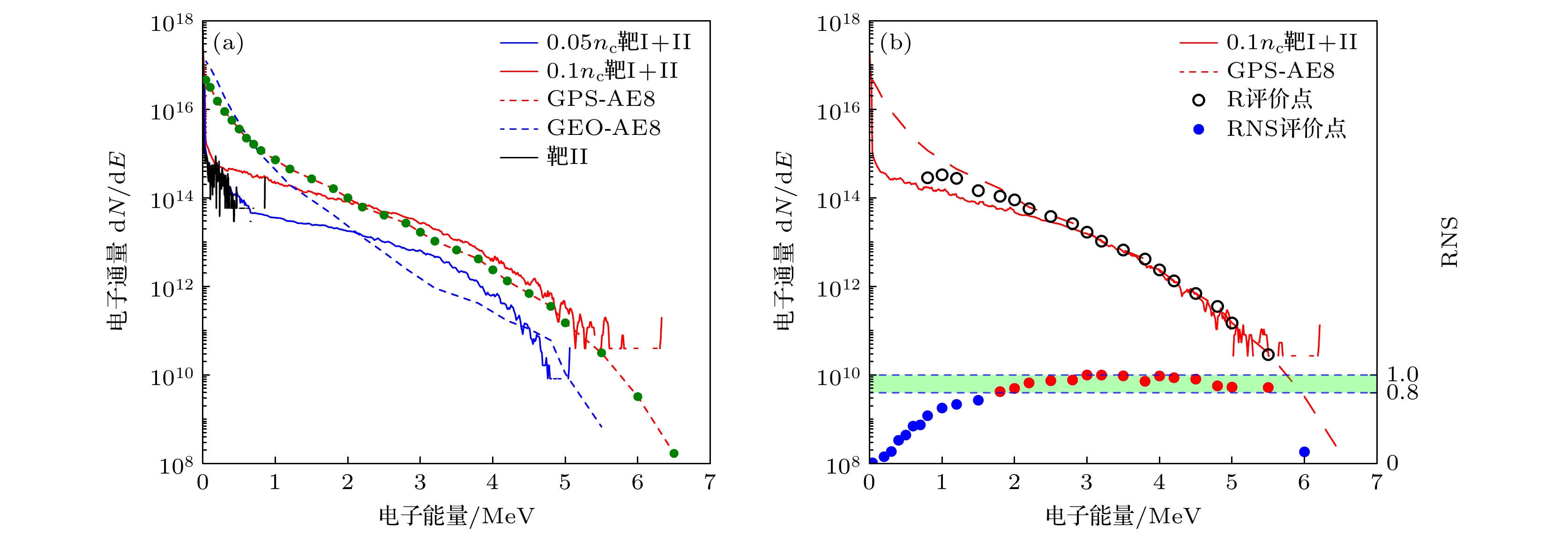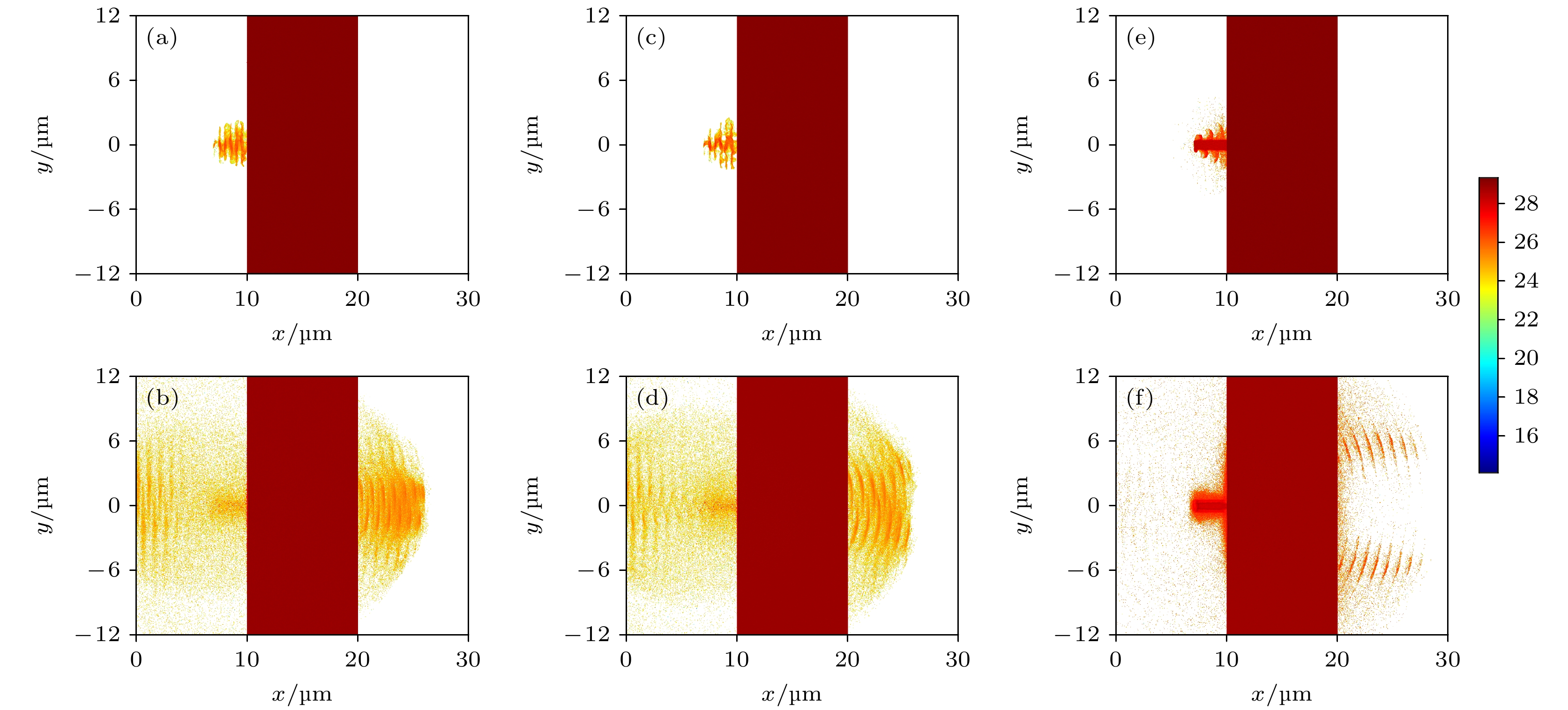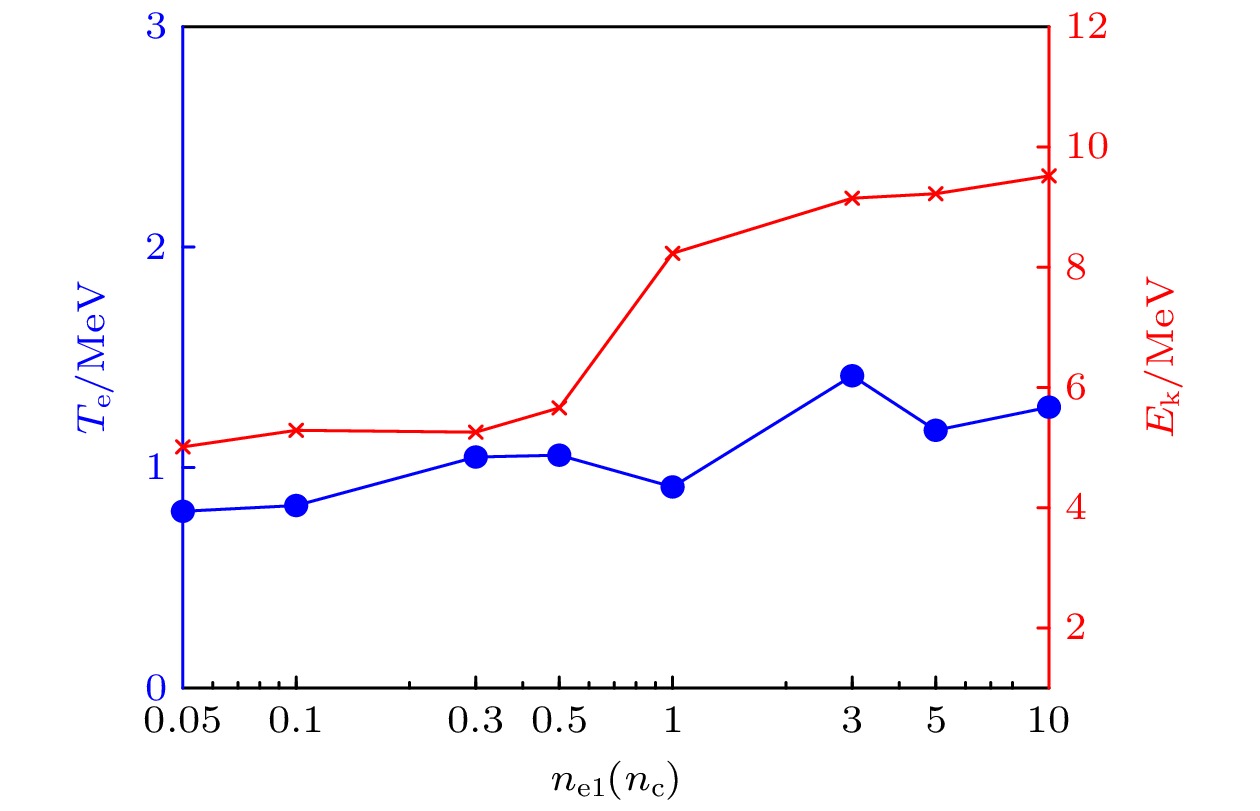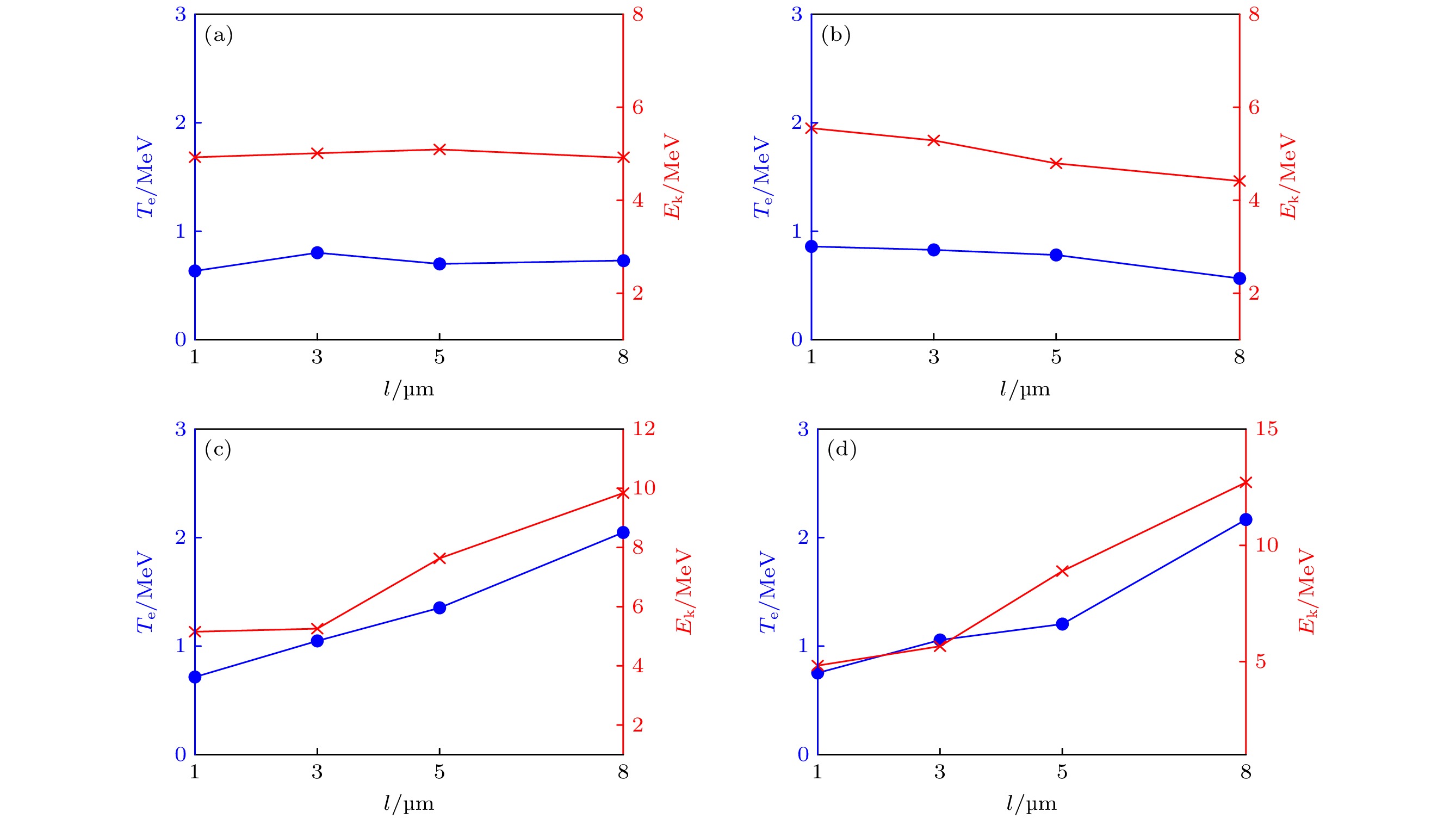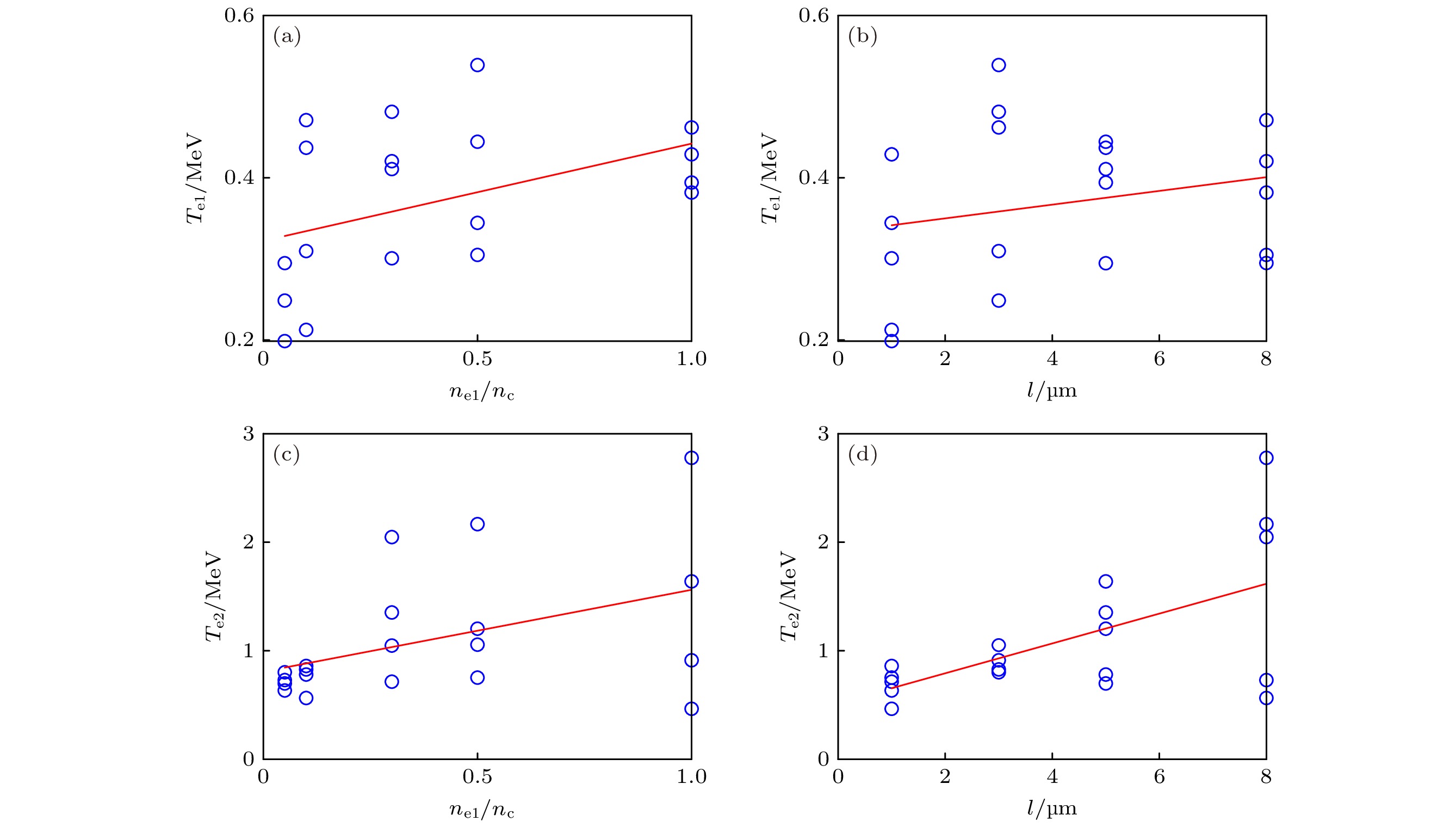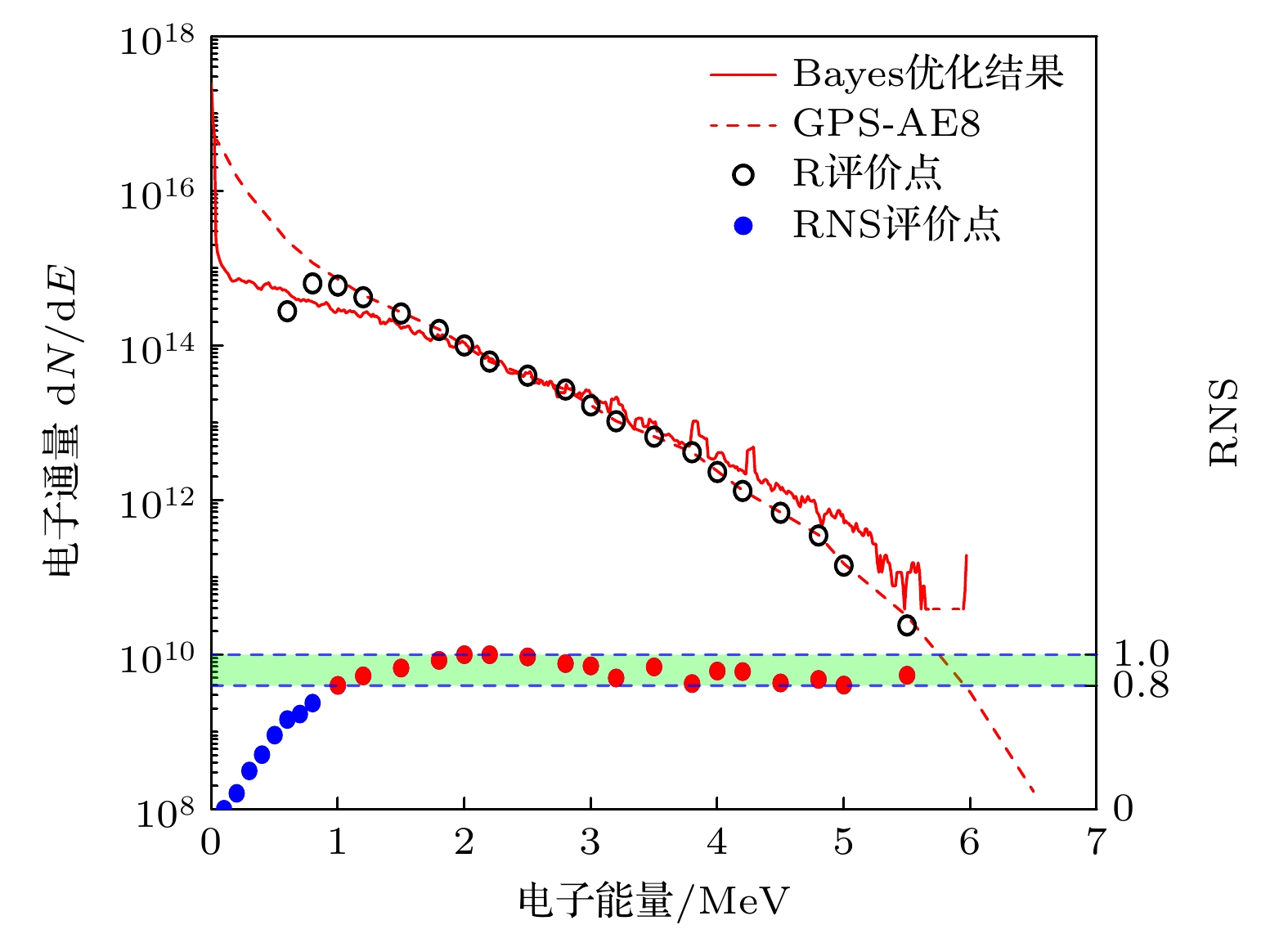-
Laser driven electron beam has important application value in the field of space radiation environment simulation. However, due to the shortcomings of poor spectrum tunability and high laser energy of the electron beam generated by laser direct irradiation of high-density solid targets, its wide application is limited. In this work, a scheme is proposed to simulate the orbital electron radiation in near-Earth space by using laser driven dual-plane composite target electron acceleration. It is found that the high-density solid target II can provide a large number of low energy electrons, while the vertical plane target I located in the front surface of target II can provide a small number of high energy electrons, which makes the electron energy spectrum very close to that of the space radiation environment. In order to evaluate the similarity between the generated energy spectrum and the space radiation spectrum, a method of evaluating the similarity of energy spectra is proposed, which can describe the local similarity and the global similarity of the energy spectra. For vertical plane target I with low density, the electron acceleration is dominated by the laser ponderomotive acceleration that generates a half-wavelength oscillation. As the density increases, the electron acceleration gradually transitions from the laser ponderomotive acceleration to the surface ponderomotive acceleration, and the electron beam energy spectrum is modulated effectively. Meanwhile, the electron temperature of the generated electron beam is linearly related to the length and density of the target I, and the optimal target parameters are obtained by the Bayesian optimization, and the generated electron beam is much better matched to the space radiation environment. Compared with the scheme of laser driven single-plane target electron acceleration, the proposed scheme has better tunability of energy spectrum and lower requirement of laser intensity. The results provide a theoretical reference for the experimental study of simulating space radiation environments in different orbitals by using laser-driven electron beams.
-
Keywords:
- ultra-short and ultra-intense laser /
- composite structure target /
- electron acceleration /
- space radiation environment simulation
[1] Summeers D, Stone S 2022 J. Geophys. Res. Space Phys. 127 JA030698
 Google Scholar
Google Scholar
[2] 黄建国, 韩建伟 2010 59 2907
 Google Scholar
Google Scholar
Huang J G, Han J W 2010 Acta Phys. Sin. 59 2907
 Google Scholar
Google Scholar
[3] Heynderickx D 2002 Int. J. Mod. Phys. A 17 1675
 Google Scholar
Google Scholar
[4] Ginet P G, Brien T P O, Huston S L, Johnston W R, Guild T B, Friedel R, Lindstrom C D, Roth C J, Whelan P, Quinn R A, Madden D, Morley S, Su Y J 2013 Space Sci Rev. 179 579
 Google Scholar
Google Scholar
[5] 陈伟, 杨海亮, 郭晓强, 姚志斌, 丁李利, 王祖军, 王晨辉, 王忠明, 丛培天 2017 科学通报 62 978
 Google Scholar
Google Scholar
Chen W, Yang H L, Guo X Q, Yao Z B, Ding L L, Wang Z J, Wang C H, Wang Z M, Cong P T 2017 Chin. Sci. Bull. 62 978
 Google Scholar
Google Scholar
[6] Bengtson M T, Hooper C T, Hoffmann R C, Engelhart D P, Murray V J, Ferguson D C 2022 J Astronaut Sci. 69 149
 Google Scholar
Google Scholar
[7] Hidding B, Königstein T, Willi O, Rosenzweig J B, Nakajima K, Pretzler G 2011 Ncucl Instrum Meth A 636 31
 Google Scholar
Google Scholar
[8] Königstein T, Karger O, Pretzler G, Rosenzweig J B, Hidding B 2012 J Plasma Phys. 78 383
 Google Scholar
Google Scholar
[9] Hidding B, Karer O, Königstein T, Pretzler G, Manahan G G, Mckenna P, Gray R, Wilson R, Wiggins S M, Welsh G H, Beaton A, Delinikolas P, Jaroszynski D A, Rosenzweig J B, Karmakar A, Ferlet-Cavrois V, Cosrantino A, Muschitiello M, Daly E 2017 Sci. Rep. 7 42354
 Google Scholar
Google Scholar
[10] Budrigă O, Ticos C M 2020 Plasma Phys. Control. Fusion 62 124001
 Google Scholar
Google Scholar
[11] Li X F, Gibbon P, Hützen A, Büscher M, Weng S M, Chen M, Sheng Z M 2021 Phy. Rev. E 104 015216
 Google Scholar
Google Scholar
[12] Liu B, Shi M Y, Zepf M, Lei B F, Seipt D 2022 Phys. Rev. Lett. 129 274801
 Google Scholar
Google Scholar
[13] Tajima T, Dawson J M 1979 Phys. Rev. Lett. 43 267
 Google Scholar
Google Scholar
[14] Zhang G B, Chen M, Zou D B, Zhu X Z, Li B Y, Yang X H, Liu F, Yu T P, Ma Y Y, Sheng Z M 2022 Phys. Rev. Appl. 17 024051
 Google Scholar
Google Scholar
[15] Ke L T, Feng K, Wang W T, Qin Z Y, Yu C H, Wu Y, Chen Y, Qi R, Zhang Z J, Xu Y, Yang X J, Leng Y X, Liu J S, Li R X, Xu Z Z 2021 Phys. Rev. Lett. 126 214801
 Google Scholar
Google Scholar
[16] Shou Y R, Wang P J, Seong G L, Yong J R, Hwang W L, Jin W Y, Jae H S, Seong K L, Pan Z, Kong D F, Mei Z S, Liu J B, Xu S R, Deng Z G, Zhou W M, Tajima T, Choi I W, Yan X Q, Chang H N, Ma W J 2023 Nat. Photonics. 17 137
 Google Scholar
Google Scholar
[17] Carbajo S, Nanni E A, Wong L J, Moriena G, Keathley P D, Laurent G, Miller R J D, Kärtner F X 2016 Phys. Rev. Accel. Beams. 19 021303
 Google Scholar
Google Scholar
[18] Babjak R, Willingale L, Arefiev A, Vranic M 2024 Phys. Rev. Lett. 132 125001
 Google Scholar
Google Scholar
[19] Yu W, Bychenkov V, Sentoku Y, Yu M Y, Sheng Z M, Mima K 2000 Phy. Rev. Lett. 85 570
 Google Scholar
Google Scholar
[20] He F, Yu W, Lu P X, Xu H, Qian L J, Shen B F, Yuan X, Li R X, Xu Z Z 2003 Phy. Rev. E. 68 046407
 Google Scholar
Google Scholar
[21] 刘明伟, 龚顺风, 李劲, 姜春蕾, 张禹涛, 周并举 2015 64 145201
 Google Scholar
Google Scholar
Liu M W, Gong S F, Jin L, Jiang C L, Zhang Y T, Zhou B J 2015 Acta Phys. Sin. 64 145201
 Google Scholar
Google Scholar
[22] Kruer W L, Estabrook 1985 Phys. Fluids. 28 430
 Google Scholar
Google Scholar
[23] Lefebvre E, Bonnaud G 1997 Phy. Rev. E 55 1
 Google Scholar
Google Scholar
[24] 静国梁, 余玮, 李英骏, 赵诗华, 钱列加, 田友伟, 刘丙辰 2006 55 3475
 Google Scholar
Google Scholar
Jing G L, Yu W, Li Y J, Zhao S H, Qian L J, Tian Y W, Liu B C 2006 Acta Phys. Sin. 55 3475
 Google Scholar
Google Scholar
[25] Grimes M K, Rundquist A R, Lee Y S, Downer M C 1999 Phy. Rev. Lett. 82 4010
 Google Scholar
Google Scholar
[26] Wang W T, Liu J S, Cai Y, Wang C, Liu L, Xia Z Q, Deng A H, Xu Y, Leng Y X, Li R X, Xu Z Z 2010 Phys. Plasmas 17 023108
 Google Scholar
Google Scholar
[27] Chopimeau L, Leblanc, Blaclard, Denoeud A, Thévenet M, Vay J L, Bonnaud G, Martin Ph, Vincenti H, Quéré F 2019 Phys. Rev. X. 9 011050
 Google Scholar
Google Scholar
[28] Haines M G, Wei M S, Beg F N, Stephens R B 2009 Phy. Rev. Lett. 102 045008
 Google Scholar
Google Scholar
[29] Ma W J, Kim Jong, Yu J Q, Choi W I, Singh P K, Lee Hwang W L, Sung J H, Seong K L, Lin C, Liao Q, Zhu J G, Lu H Y, Liu B, Wang H Y, Xu R F, He X T, Chen J E, Zepf M, Schreiber J, Yan X Q, Nam C H 2019 Phy. Rev. Lett. 122 014803
 Google Scholar
Google Scholar
[30] Lad A D, Mishima Y, Singh P K, Li B Y, Adak A, Chatterjee G, Brijesh P, Dalui M, Inoue M, Jha J, Tata S, Trivilram M, Krishnamurthy M, Chen M, Sheng Z M, Tanaka K A, Kumar R G, Habara H 2022 Sci. Rep. 12 16818
 Google Scholar
Google Scholar
[31] Shen X F, Pukhov A, Qiao B 2023 Plasma Phys. Control. Fusion 65 034005
 Google Scholar
Google Scholar
[32] Yang X H, Dieckmann M E, Sarri G, Borghesi M 2012 Phys. Plasmas 19 113110
 Google Scholar
Google Scholar
[33] Zhang G B, Ma Y Y, Han X, Nasr A M, Yang X H, Chen M, Yu T P, Zou D B, Liu J X, Yan J F, Zhuo H B, Gan L F, Tian L C, Shao F Q, Yin Y, Kawata S 2015 Phys. Plasmas 22 0831110
 Google Scholar
Google Scholar
[34] Zhou L, Yang Z B, Yang J, Wu Y G, Wei D S 2017 Chem. Phys. Lett. 677 7
 Google Scholar
Google Scholar
[35] Fronya A A, Borisenko N G, Sahakyan A T, Puzyrev V N, Starodub A N, Yakushev O F 2019 Phys. Atom. Nuclei. 82 1429
 Google Scholar
Google Scholar
[36] Hodson T O 2022 Geosci Model Dev. 15 5481
 Google Scholar
Google Scholar
[37] Staerk C, Klinkhammer Hannah, Wistuba T, Maj C Mayr A 2024 BMC Med Genomics. 17 132
 Google Scholar
Google Scholar
[38] Ma Y Y, Sheng Z S, Li Y T, Chang W W, Yuan X H, Chen M, Wu H C, Zheng J, Zhang J 2006 Phys. Plasmas 13 110702
 Google Scholar
Google Scholar
[39] Marini S, Grech M, Kleij P S, Raynaud M, Riconda C 2023 Phys. Rev. Res. 5 013115
 Google Scholar
Google Scholar
[40] Vladisavlevici I M, Vizman D, d'Humières E 2023 Plasma Phys. Control. Fusion 65 045012
 Google Scholar
Google Scholar
[41] Box G E P 1953 Biometrika 40 318
 Google Scholar
Google Scholar
[42] Diessner M, O’Connor J, Wynn A, Laizet S, Guan Y, Wilson K, Whalley R D 2022 Front. Appl. Math. Stat. 08 1076296
 Google Scholar
Google Scholar
[43] Liu J W, Xiao Y K, Duan X J, Chen X, Wang Z M, Liu Z C 2024 Eng. Optim DOI: 10.1080/0305215X.2024.2328788
-
图 2 (a) $t = 48\;{T_{0}}$时, 不同密度垂直平面靶Ⅰ情况和典型轨道的电子能谱分布; (b) 靶Ⅰ密度为$0.1\;{n_{\text{c}}}$时, 利用R和RNS方法评价模拟结果与GPS轨道电子能谱匹配程度的结果(RNS评价值大于0.8的点标记为红色)
Figure 2. (a) Electron energy spectrum distributions of typical orbit and the perpendicular plane target Ⅰ with different densities at $t = 48\;{T_{0}}$; (b) the evaluation results obtained by R and RNS method between simulation results and the GPS orbital electron flux when the density of target Ⅰ is $0.1\;{n_{\text{c}}}$ (dots with RNS greater than 0.8 are marked in red).
图 3 $ t = 18{T_0} $(第1行)和$t = 34{T_0}$(第2行)时刻, 不同密度垂直平面靶Ⅰ的电子密度空间分布 (a), (b) $0.05{n_{\text{c}}}$; (c), (d) $0.1{n_{\text{c}}}$; (e), (f) $10{n_{\text{c}}}$
Figure 3. Spatial distributions of the electron density of the perpendicular plane target I with $0.05{n_{\text{c}}}$ (a), (b); $0.1{n_{\text{c}}}$ (c), (d); $10{n_{\text{c}}}$ (e), (f) at $ t = 18{T_0} $ (the first row) and $t = 34{T_0}$ (the second row) .
图 5 $t = 48\;{T_{0}}$时刻, 不同密度靶Ⅰ的高能端电子温度(蓝线)与电子最大能量(红线)随靶Ⅰ长度的演化 (a) ne1 = 0.05nc; (b) ne1 = 0.1nc; (c) ne1 = 0.3nc; (d) ne1 = 0.5nc
Figure 5. Evolution of the electron temperature (blue line) and the maximum electron energy (red line) for different lengths of target I at $t = 48\;{T_{0}}$: (a) ne1 = 0.05nc; (b) ne1 = 0.1nc; (c) ne1 = 0.3nc; (d) ne1 = 0.5nc.
图 6 电子束能谱的低能端电子温度Te1和高能端电子温度Te2随(a), (c)靶Ⅰ密度${n_{{\text{e}}1}}$和(b), (d)长度$l$演化, 蓝色散点为靶Ⅰ密度分别为0.05nc, 0.1nc, 0.3nc, 0.5nc, 1nc与长度分别为$1\;{\text{μm}}$, $3\;{\text{μm}}$, $5\;{\text{μm}}$, $8\;{\text{μm}}$时每种情况的20组数据, 红线为拟合线性方程
Figure 6. Evolution of the electron temperature Te1 at the low energy and Te2 at the high energy evolve with the density (a), (c) and length (b), (d) of the target I. The blue scatter dots represent 20 sets of data with target I densities of 0.05nc, 0.1nc, 0.3nc, 0.5nc, 1nc and lengths of $1\;{\text{μm}}$, $3\;{\text{μm}}$, $5\;{\text{μm}}$, $8\;{\text{μm}}$, respectively, and the red line represents the fitted linear equation.
-
[1] Summeers D, Stone S 2022 J. Geophys. Res. Space Phys. 127 JA030698
 Google Scholar
Google Scholar
[2] 黄建国, 韩建伟 2010 59 2907
 Google Scholar
Google Scholar
Huang J G, Han J W 2010 Acta Phys. Sin. 59 2907
 Google Scholar
Google Scholar
[3] Heynderickx D 2002 Int. J. Mod. Phys. A 17 1675
 Google Scholar
Google Scholar
[4] Ginet P G, Brien T P O, Huston S L, Johnston W R, Guild T B, Friedel R, Lindstrom C D, Roth C J, Whelan P, Quinn R A, Madden D, Morley S, Su Y J 2013 Space Sci Rev. 179 579
 Google Scholar
Google Scholar
[5] 陈伟, 杨海亮, 郭晓强, 姚志斌, 丁李利, 王祖军, 王晨辉, 王忠明, 丛培天 2017 科学通报 62 978
 Google Scholar
Google Scholar
Chen W, Yang H L, Guo X Q, Yao Z B, Ding L L, Wang Z J, Wang C H, Wang Z M, Cong P T 2017 Chin. Sci. Bull. 62 978
 Google Scholar
Google Scholar
[6] Bengtson M T, Hooper C T, Hoffmann R C, Engelhart D P, Murray V J, Ferguson D C 2022 J Astronaut Sci. 69 149
 Google Scholar
Google Scholar
[7] Hidding B, Königstein T, Willi O, Rosenzweig J B, Nakajima K, Pretzler G 2011 Ncucl Instrum Meth A 636 31
 Google Scholar
Google Scholar
[8] Königstein T, Karger O, Pretzler G, Rosenzweig J B, Hidding B 2012 J Plasma Phys. 78 383
 Google Scholar
Google Scholar
[9] Hidding B, Karer O, Königstein T, Pretzler G, Manahan G G, Mckenna P, Gray R, Wilson R, Wiggins S M, Welsh G H, Beaton A, Delinikolas P, Jaroszynski D A, Rosenzweig J B, Karmakar A, Ferlet-Cavrois V, Cosrantino A, Muschitiello M, Daly E 2017 Sci. Rep. 7 42354
 Google Scholar
Google Scholar
[10] Budrigă O, Ticos C M 2020 Plasma Phys. Control. Fusion 62 124001
 Google Scholar
Google Scholar
[11] Li X F, Gibbon P, Hützen A, Büscher M, Weng S M, Chen M, Sheng Z M 2021 Phy. Rev. E 104 015216
 Google Scholar
Google Scholar
[12] Liu B, Shi M Y, Zepf M, Lei B F, Seipt D 2022 Phys. Rev. Lett. 129 274801
 Google Scholar
Google Scholar
[13] Tajima T, Dawson J M 1979 Phys. Rev. Lett. 43 267
 Google Scholar
Google Scholar
[14] Zhang G B, Chen M, Zou D B, Zhu X Z, Li B Y, Yang X H, Liu F, Yu T P, Ma Y Y, Sheng Z M 2022 Phys. Rev. Appl. 17 024051
 Google Scholar
Google Scholar
[15] Ke L T, Feng K, Wang W T, Qin Z Y, Yu C H, Wu Y, Chen Y, Qi R, Zhang Z J, Xu Y, Yang X J, Leng Y X, Liu J S, Li R X, Xu Z Z 2021 Phys. Rev. Lett. 126 214801
 Google Scholar
Google Scholar
[16] Shou Y R, Wang P J, Seong G L, Yong J R, Hwang W L, Jin W Y, Jae H S, Seong K L, Pan Z, Kong D F, Mei Z S, Liu J B, Xu S R, Deng Z G, Zhou W M, Tajima T, Choi I W, Yan X Q, Chang H N, Ma W J 2023 Nat. Photonics. 17 137
 Google Scholar
Google Scholar
[17] Carbajo S, Nanni E A, Wong L J, Moriena G, Keathley P D, Laurent G, Miller R J D, Kärtner F X 2016 Phys. Rev. Accel. Beams. 19 021303
 Google Scholar
Google Scholar
[18] Babjak R, Willingale L, Arefiev A, Vranic M 2024 Phys. Rev. Lett. 132 125001
 Google Scholar
Google Scholar
[19] Yu W, Bychenkov V, Sentoku Y, Yu M Y, Sheng Z M, Mima K 2000 Phy. Rev. Lett. 85 570
 Google Scholar
Google Scholar
[20] He F, Yu W, Lu P X, Xu H, Qian L J, Shen B F, Yuan X, Li R X, Xu Z Z 2003 Phy. Rev. E. 68 046407
 Google Scholar
Google Scholar
[21] 刘明伟, 龚顺风, 李劲, 姜春蕾, 张禹涛, 周并举 2015 64 145201
 Google Scholar
Google Scholar
Liu M W, Gong S F, Jin L, Jiang C L, Zhang Y T, Zhou B J 2015 Acta Phys. Sin. 64 145201
 Google Scholar
Google Scholar
[22] Kruer W L, Estabrook 1985 Phys. Fluids. 28 430
 Google Scholar
Google Scholar
[23] Lefebvre E, Bonnaud G 1997 Phy. Rev. E 55 1
 Google Scholar
Google Scholar
[24] 静国梁, 余玮, 李英骏, 赵诗华, 钱列加, 田友伟, 刘丙辰 2006 55 3475
 Google Scholar
Google Scholar
Jing G L, Yu W, Li Y J, Zhao S H, Qian L J, Tian Y W, Liu B C 2006 Acta Phys. Sin. 55 3475
 Google Scholar
Google Scholar
[25] Grimes M K, Rundquist A R, Lee Y S, Downer M C 1999 Phy. Rev. Lett. 82 4010
 Google Scholar
Google Scholar
[26] Wang W T, Liu J S, Cai Y, Wang C, Liu L, Xia Z Q, Deng A H, Xu Y, Leng Y X, Li R X, Xu Z Z 2010 Phys. Plasmas 17 023108
 Google Scholar
Google Scholar
[27] Chopimeau L, Leblanc, Blaclard, Denoeud A, Thévenet M, Vay J L, Bonnaud G, Martin Ph, Vincenti H, Quéré F 2019 Phys. Rev. X. 9 011050
 Google Scholar
Google Scholar
[28] Haines M G, Wei M S, Beg F N, Stephens R B 2009 Phy. Rev. Lett. 102 045008
 Google Scholar
Google Scholar
[29] Ma W J, Kim Jong, Yu J Q, Choi W I, Singh P K, Lee Hwang W L, Sung J H, Seong K L, Lin C, Liao Q, Zhu J G, Lu H Y, Liu B, Wang H Y, Xu R F, He X T, Chen J E, Zepf M, Schreiber J, Yan X Q, Nam C H 2019 Phy. Rev. Lett. 122 014803
 Google Scholar
Google Scholar
[30] Lad A D, Mishima Y, Singh P K, Li B Y, Adak A, Chatterjee G, Brijesh P, Dalui M, Inoue M, Jha J, Tata S, Trivilram M, Krishnamurthy M, Chen M, Sheng Z M, Tanaka K A, Kumar R G, Habara H 2022 Sci. Rep. 12 16818
 Google Scholar
Google Scholar
[31] Shen X F, Pukhov A, Qiao B 2023 Plasma Phys. Control. Fusion 65 034005
 Google Scholar
Google Scholar
[32] Yang X H, Dieckmann M E, Sarri G, Borghesi M 2012 Phys. Plasmas 19 113110
 Google Scholar
Google Scholar
[33] Zhang G B, Ma Y Y, Han X, Nasr A M, Yang X H, Chen M, Yu T P, Zou D B, Liu J X, Yan J F, Zhuo H B, Gan L F, Tian L C, Shao F Q, Yin Y, Kawata S 2015 Phys. Plasmas 22 0831110
 Google Scholar
Google Scholar
[34] Zhou L, Yang Z B, Yang J, Wu Y G, Wei D S 2017 Chem. Phys. Lett. 677 7
 Google Scholar
Google Scholar
[35] Fronya A A, Borisenko N G, Sahakyan A T, Puzyrev V N, Starodub A N, Yakushev O F 2019 Phys. Atom. Nuclei. 82 1429
 Google Scholar
Google Scholar
[36] Hodson T O 2022 Geosci Model Dev. 15 5481
 Google Scholar
Google Scholar
[37] Staerk C, Klinkhammer Hannah, Wistuba T, Maj C Mayr A 2024 BMC Med Genomics. 17 132
 Google Scholar
Google Scholar
[38] Ma Y Y, Sheng Z S, Li Y T, Chang W W, Yuan X H, Chen M, Wu H C, Zheng J, Zhang J 2006 Phys. Plasmas 13 110702
 Google Scholar
Google Scholar
[39] Marini S, Grech M, Kleij P S, Raynaud M, Riconda C 2023 Phys. Rev. Res. 5 013115
 Google Scholar
Google Scholar
[40] Vladisavlevici I M, Vizman D, d'Humières E 2023 Plasma Phys. Control. Fusion 65 045012
 Google Scholar
Google Scholar
[41] Box G E P 1953 Biometrika 40 318
 Google Scholar
Google Scholar
[42] Diessner M, O’Connor J, Wynn A, Laizet S, Guan Y, Wilson K, Whalley R D 2022 Front. Appl. Math. Stat. 08 1076296
 Google Scholar
Google Scholar
[43] Liu J W, Xiao Y K, Duan X J, Chen X, Wang Z M, Liu Z C 2024 Eng. Optim DOI: 10.1080/0305215X.2024.2328788
Catalog
Metrics
- Abstract views: 1993
- PDF Downloads: 90
- Cited By: 0














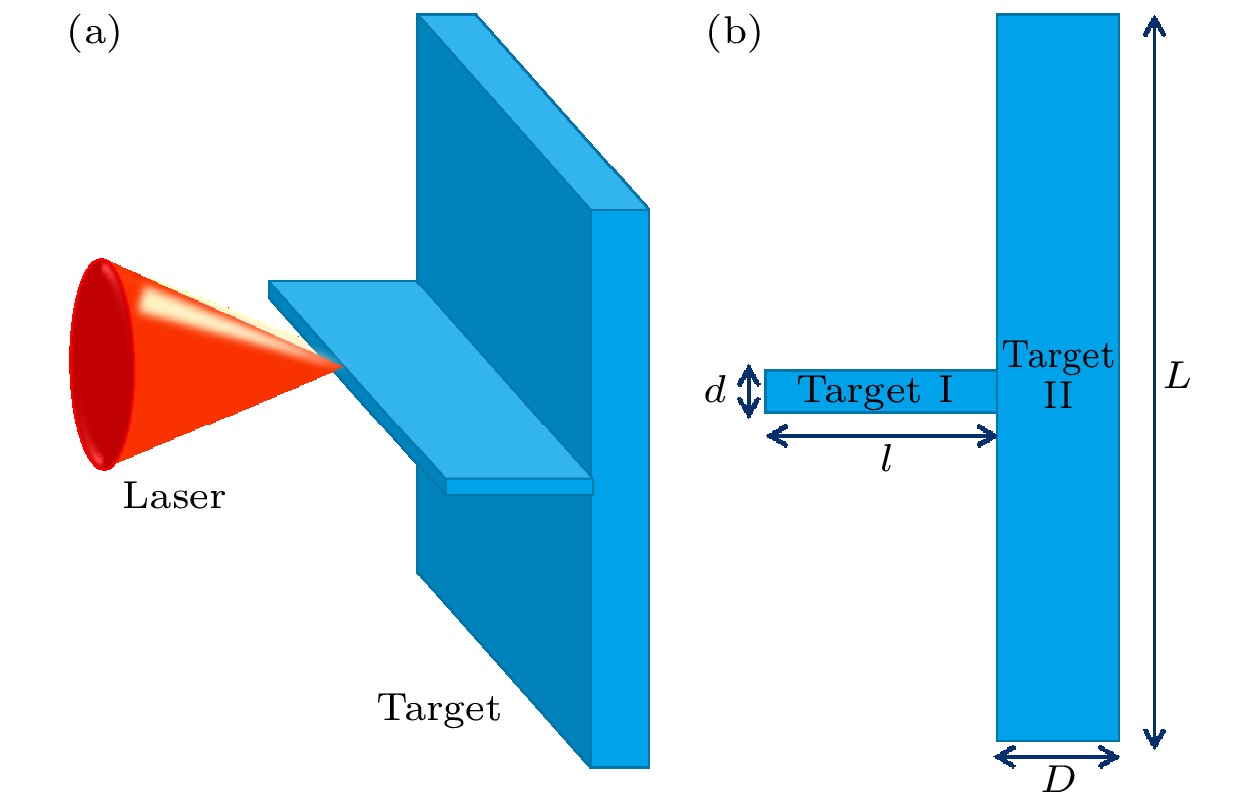
 DownLoad:
DownLoad:
